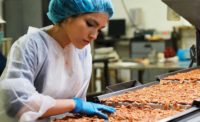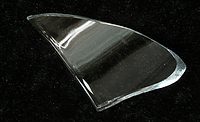LEDs Can Control Food Contamination without Chemicals

In what promises to be an alternative food preservation technology, light-emitting diodes (LEDs) have proven their potential in killing foodborne pathogens, without the need for any chemicals.
A team of researchers from the National University of Singapore has demonstrated the efficacy of LEDs in inactivating foodborne pathogens such as Escherichia coli O157:H7, Salmonella Typhimurium and Listeria monocytogenes. The scientists used blue LEDs of peak wavelength 461 nm against the pathogens, which were suspended in the growth medium tryptone soya broth at a temperature of 15 °C. While the temperature was fixed, the illumination time was varied from 0 to 7.5 h. This meant that the LEDs, which had an intensity of 22 mW/cm2, supplied a dosage of nearly 600 J/cm2 at the end of the illumination period. The acidity of the suspension medium was also varied over a wide range, with pH levels tested ranging from 4.5 to 9.5. To evaluate the effect of the LEDs, the fate of the pathogens on illumination was compared to controls, which were maintained at the same pH but were not exposed to light.
The acidity of the medium was observed to have a profound effect on the outcome of LED illumination.[1] Greater susceptibility of all the bacteria could be discerned when the pH was shifted from near-neutral to acidic or alkaline extremes. Moreover, a trend was noticed within this susceptibility. The two Gram-negative pathogens, E. coli O157:H7 and S. Typhimurium, were much more sensitive to blue light at an alkaline pH of 9.5 rather than an acidic one. Reductions of the order 4-log colony-forming units/mL were seen at this pH. Conversely, the Gram-positive L. monocytogenes displayed greater vulnerability to the LEDs at an acidic pH of 4.5 relative to an alkaline one. At this pH, the concentration of Listeria in the suspension dropped below detectable limits under the influence of the LEDs within 6 h. Significant sublethal injury was also reported whenever bacterial inactivation occurred, implying that membrane damage might be one of the causative factors in bacterial cell death. It was ascertained that the bactericidal effects witnessed in this study were due to a combination of the LEDs and the pH, and not due to the pH alone, as the control samples did not experience any inactivation whatsoever.
The antibacterial effect of LEDs stems from the ability of blue light to trigger photodynamic inactivation of bacteria. Bacterial cells contain light-sensitive compounds called porphyrins, which have absorption spectra between 400 and 430 nm. When light of this wavelength is made incident on the cells, the porphyrins are excited to a higher energy state. During their return to the ground state, these porphyrins collide with molecules or compounds of oxygen, transferring energy to them and converting them into reactive oxygen species (ROS) such as singlet oxygen, superoxide anion, hydrogen peroxide, and hydroxyl radical. These ROS initiate cytotoxic reactions, thus bringing about cell death.
This investigation demonstrates the potential of LEDs in inactivating foodborne pathogens in acidic as well as alkaline conditions. The success of this technology under acidic conditions holds promise for the preservation of raw produce such as fresh-cut fruit, which is threatened by post-harvest surface contamination at various stages from farm to fork. LEDs can be accommodated into a variety of devices and designs, such as domestic refrigerators, food court display units and supermarket shelves, given their low cost, energy efficiency and small size. Future research should be directed towards applying this technology to a greater variety of foods, against more diverse foodborne pathogens and on a larger scale.
The team has published this research in the journal Food Microbiology.[1] Besides this work, the team also evaluated the effects of temperature and organic acids on the antibacterial effect of LEDs. The details of these studies can be located in The International Journal of Food Microbiology[2] and Food Control,[3] respectively.
Hyun-Gyun Yuk, Ph.D., is an assistant professor of the food science and technology programme in the department of chemistry at the National University of Singapore.
References
1. Ghate, V, AL Leong, A Kumar, WS Bang, W Zhou and HG Yuk. 2015. Enhancing the antibacterial effect of 461 and 521 nm light-emitting diodes on selected foodborne pathogens in trypticase soy broth by acidic and alkaline pH conditions. Food Microbiol 48:49–57.
2. Ghate, VS, KS Ng, W Zhou, H Yang, GH Khoo, W-B Yoon and HG Yuk. 2013. Antibacterial effect of light emitting diodes of visible wavelengths on selected foodborne pathogens at different temperatures. Int J Food Microbiol 166:399–406.
3. Ghate, V, A Kumar, W Zhou and HG Yuk. 2015. Effect of organic acids on the photodynamic inactivation of selected foodborne pathogens using 461 nm LEDs. Food Control 57:333–340.
Looking for a reprint of this article?
From high-res PDFs to custom plaques, order your copy today!







.webp?t=1721343192)

